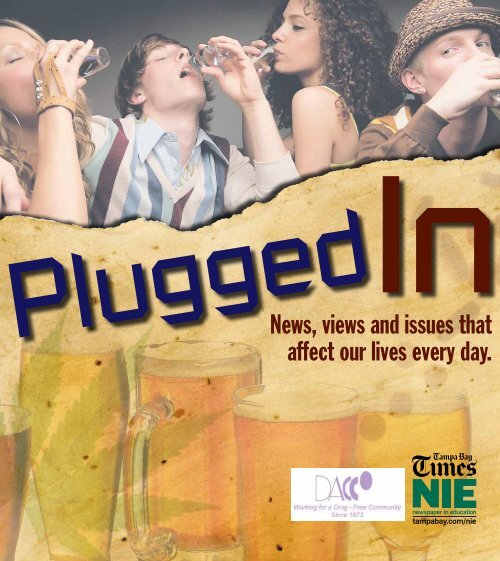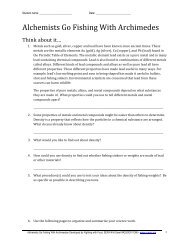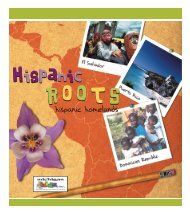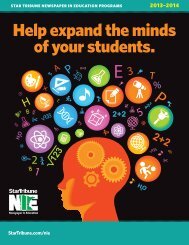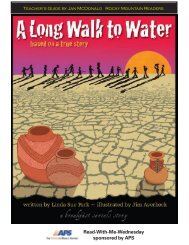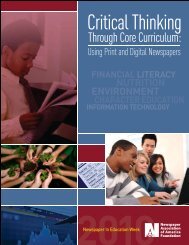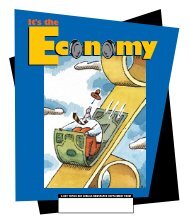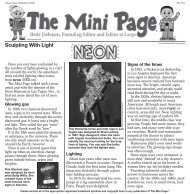News, views and issues that affect our lives every day.
News, views and issues that affect our lives every day.
News, views and issues that affect our lives every day.
- No tags were found...
You also want an ePaper? Increase the reach of your titles
YUMPU automatically turns print PDFs into web optimized ePapers that Google loves.
PluggedIn<strong>News</strong>, <strong>views</strong> <strong>and</strong> <strong>issues</strong> <strong>that</strong><strong>affect</strong> <strong>our</strong> <strong>lives</strong> <strong>every</strong> <strong>day</strong>.
“For most addicts,there’s a constant presenceon y<strong>our</strong> shoulder telling youyou’re not good enough,<strong>that</strong> somehow, you’re ‘less’than <strong>every</strong>one out there.Y<strong>our</strong> thoughts go round likea washing machine on highspeed. The noise in y<strong>our</strong>head is constant, loud <strong>and</strong>harsh. Alcohol <strong>and</strong> drugs aremerely the medication.“Addiction isn’t fun.Addiction is lonely, terrifying<strong>and</strong> insidious. Oh, sure, youstart out like <strong>every</strong>one else, afew drinks here <strong>and</strong> there, adabble or two in something alittle harder. You don’t realizewhen it stops being fun, butit does. Suddenly you findy<strong>our</strong>self alone in a room,afraid to go out, because‘outside’ is too damn scary.So you take <strong>that</strong> hit, <strong>and</strong> for ashort while, the noise stops.Peace through oblivion. Thenyou come around <strong>and</strong> thenoise starts again, louder thistime, <strong>and</strong> coupled with theanxiety, fear <strong>and</strong> terror <strong>that</strong>come with withdrawal.“So you take another hit.Sweet, blessed relief. Andsomewhere in the back ofy<strong>our</strong> mind you hope you don’twake up from this one. You’renothing but trouble, you see.All you cause is pain <strong>and</strong>worry.”— Kristian JohnsChanging timesThroughout much of the last century, scientistsstudying drug abuse labored in the shadowsof powerful myths <strong>and</strong> misconceptions about thenature of addiction, according to the NationalInstitute on Drug Abuse. Back in the 1930s, it wasassumed <strong>that</strong> people addicted to drugs werelacking in willpower.To<strong>day</strong>, thanks to science, <strong>our</strong> <strong>views</strong> <strong>and</strong><strong>our</strong> responses to drug abuse have changeddramatically. Groundbreaking discoveries aboutthe brain have revolutionized <strong>our</strong> underst<strong>and</strong>ingof drug addiction, enabling us to respondeffectively to the problem. As a result ofscientific research, we know <strong>that</strong> addiction is adisease <strong>that</strong> <strong>affect</strong>s both brain <strong>and</strong> behavior.Research has shown <strong>that</strong> people generallytake drugs to feel good, feel better or copewith difficult problems or situations. Youcannot turn on the television, listen to theradio or pick up a magazine without seeing anadvertisement promoting some substance <strong>that</strong>will improve y<strong>our</strong> life. This Tampa Bay Times<strong>News</strong>paper in Education publication, created inpartnership with the Drug Abuse ComprehensiveCoordinating Office (DACCO), focuses oneducating you on substance abuse prevention.We hope this publication will serve as adiscussion tool for parents, teachers, communitymembers <strong>and</strong> youth.Addiction: a treatable diseaseWhile the initial decision to use drugs isvoluntary, drug addiction is a disease of the brain<strong>that</strong> compels a person to become singularlyobsessed with obtaining <strong>and</strong> abusing drugsdespite their many adverse health <strong>and</strong> lifeconsequences.Addiction is a primary, chronic illnessinfluenced by genetic, psychosocial,environmental <strong>and</strong> lifestyle factors. Addictionis not a sign of weak morals; it is a disease.Symptoms of addiction include loss of controlover drug or alcohol use, cravings, use despiteconsequences, distortions in thinking, the needto consume greater amounts to get high, <strong>and</strong>physical dependence <strong>and</strong> withdrawal.Like many other diseases, substance usedisorders are chronic <strong>and</strong> follow a predictablec<strong>our</strong>se. Long-term drug abuse results in changesin the brain <strong>that</strong> persist long after a person stopsusing. The good news is <strong>that</strong> addiction, like otherdiseases, can be successfully treated. Peopleall around the world are recovering to live long,healthy <strong>and</strong> happy <strong>lives</strong>!The best treatment programs are scientificallybased <strong>and</strong> meet the multiple needs of theindividual, not just his or her drug use. It isimportant to remember <strong>that</strong> no single treatmentis appropriate for all individuals.S<strong>our</strong>ces: National Institute on Drug Abuse, NationalInstitute on Alcohol Abuse <strong>and</strong> Alcoholism of the NationalInstitutes of Health, <strong>and</strong> the Department of Health & HumanServices Centers for Disease Control <strong>and</strong> Prevention2 tampabay.com/nie
HillsboroughPreventionCollaborativeIn November 2010, several local leadersin Hillsborough County, Florida, formed theHillsborough Prevention Collaborative (HPC) towork together to deal with community <strong>issues</strong>such as alcohol <strong>and</strong> drug abuse, violence, ganginvolvement, teen pregnancy, school failure,youth crime <strong>and</strong> obesity.The HPC has had participation fromthe Hillsborough County Board of CountyCommissioners, the Children’s Board ofHillsborough County, Hillsborough CountyPublic Schools, the Hillsborough CountySheriff’s Office, the Central Florida BehavioralHealth Network, the Florida Department ofChildren <strong>and</strong> Families Suncoast Region, theU.S. Attorney’s Office Middle District, the FamilyJustice Center, DACCO, Mental Health CareInc., ACTS, the Mendez Foundation, the Centre,Boys <strong>and</strong> Girls Clubs of Tampa Bay, the CrisisCenter of Tampa Bay, Bay Area Youth Services,Success 4 Kids <strong>and</strong> Families, the Child AbuseCouncil, Hillsborough Kids Inc., the HealthyStart Coalition, the Hillsborough Healthy TeenNetwork, the Florida Institute for CommunityStudies, St. Joseph’s Children’s HospitalAdvocacy Center, Abe Brown Ministries <strong>and</strong>Beulah Baptist Institutional Church.Community members, including students,parents, schools, churches <strong>and</strong> businesses,can work with the Hillsborough PreventionCollaborative to make sure health, wellness<strong>and</strong> success are promoted in all aspects ofcommunity life – family, friends, school, work,social, business, neighborhoods <strong>and</strong> so on. Thiscan be done through activities <strong>that</strong>• raise awareness about health <strong>and</strong> theprevention of illegal drug use, underagedrinking, prescription drug abuse, violence<strong>and</strong> failing school• promote healthy individual, neighborhood,school <strong>and</strong> family relationships• provide information to community membersso they can make positive choices• try to change parts of the communityenvironment <strong>that</strong> promote unhealthy orunsafe choicesThere are many ways you can getconnected with the Hillsborough PreventionCollaborative. Visit us at https://sites.google.com/site/hillsboroughprevention/, e-mail us athillsboroughprevention@gmail.com, or look forus on Facebook.Drug Abuse Comprehensive Coordinating OfficeThe Drug Abuse Comprehensive Coordinating Office’s(DACCO) mission is to work for a drug-free community– one person, one family at a time. DACCO reachesHillsborough County residents through communityeducation, prevention, assessment <strong>and</strong> referrals,support services, intervention, <strong>and</strong> outpatient <strong>and</strong>residential treatment.Research shows <strong>that</strong> the use of alcohol, tobacco <strong>and</strong>other drugs is associated with specific aspects of ayoung person’s community, school, family environment<strong>and</strong> individual characteristics. These aspects arecalled risk or protective factors. Effective preventionprograms identify which risk factors are elevatedin the community <strong>and</strong> which protective factors aresuppressed, <strong>and</strong> then implement programming <strong>that</strong>specifically targets those factors.Prevention strategies include education onsubstance abuse <strong>and</strong> its risk, as well as short-termactions focused on changing individual behavior.Environmental prevention strategies involve long-term,potentially permanent changes <strong>that</strong> have a broaderreach. The most effective prevention plans will use bothenvironmental <strong>and</strong> individual prevention strategies.Working in various locations, DACCO educates youth,adults <strong>and</strong> families about preventing substance abuse.Now in its third year, the DACCO-led Community AlcoholPrevention Grant Collaborative is targeting youngadults through a countywide educational campaign<strong>that</strong> highlights state laws, campus alcohol policies, thenature of blood alcohol concentration <strong>and</strong> the needto self-monitor alcohol use. Partners in this initiativeinclude the University of South Florida, the Universityof Tampa, 10 Connects CBS Tampa Bay <strong>and</strong> the TampaBay Times.DACCO provides a range of treatment servicesfor individuals <strong>and</strong> families in need. DACCO treatssubstance use disorders in outpatient <strong>and</strong> residentialsettings <strong>and</strong> addresses co-occurring mental health<strong>issues</strong>, such as anxiety, depression <strong>and</strong> post-traumaticstress disorder (PTSD).DACCO offers supportive services to help clientsstay engaged in treatment, meet all their health careneeds <strong>and</strong> improve their <strong>lives</strong>, including HIV testing <strong>and</strong>counseling, adult education/GED, primary health care,<strong>day</strong> care <strong>and</strong> affordable housing. DACCO offers bothoutpatient <strong>and</strong> adult residential treatment programs.Both outpatient <strong>and</strong> residential programs includedifferent intensities of individual, group <strong>and</strong> familycounseling; on-site NA/AA meetings; life skillseducation; <strong>and</strong> urine drug screening. To schedule anassessment of patient needs, call 813-984-1818, ext. 0.To learn more about DACCO’s services, visitdacco.org <strong>and</strong> click on “Community Education” tolearn more about substance abuse.tampabay.com/nie 23
I got a clear underst<strong>and</strong>ing of my addiction – how far I have comewith my recovery. I lost my friends’ <strong>and</strong> family’s trust <strong>and</strong> respectbecause I lied to them so much. I’m looking forward to gaining itback. Now <strong>that</strong> I am in recovery, I am changing my life <strong>and</strong> I love it.”— Rebecca W.Risk factorsMany risk factors <strong>affect</strong> a youngadult’s risk for substance abuse,including community deficiencies<strong>that</strong> contribute to high-risk alcoholor drug use, such as perceived risk,social norms <strong>and</strong> access to help.But many protective factors canreduce a youth or young adult’srisk for substance abuse <strong>and</strong> otherproblem behaviors, such as:• Strong positive bonding to parents/caregivers, family, friends, school• Healthy beliefs <strong>and</strong> clear st<strong>and</strong>ards• Constructive recreationopportunities• Parental disapproval of problembehavior• Parent/child connectedness; feelingunderstood, loved, wanted <strong>and</strong> paidattention to• Parental presence before school,after school, at dinner <strong>and</strong> at bedtime• Academic achievement, regularschool attendance, pro-socialopportunities• Development of critical thinking <strong>and</strong>problem-solving skills• Education about social <strong>and</strong> healthrelated costsS<strong>our</strong>ce: DACCOAll drugs have the potential to bedangerous, whether alcohol, illicitdrugs or prescription drugs. Alcoholcontinues to be the most commonlyused drug in Hillsborough County <strong>and</strong>its abuse is a leading cause of carcrashes, injury, homicide <strong>and</strong> suicide.There also has been a significantincrease in local deaths related toprescription drugs such as OxyContin.According to data from the countyMedical Examiner Department, in 2009an alarming 92 percent of HillsboroughCounty drug-related deaths involved atleast one prescription drug.According to a 2008 national survey,the intentional misuse of prescriptiondrugs is now second, only to marijuana,as the nation’s most prevalent drugabuse issue. And 70 percentof prescription painrelievers usednon-medicallyin <strong>our</strong> nationcame fromfriends orrelatives.S<strong>our</strong>ce: DACCOStopping drug<strong>and</strong> alcohol abusebefore it startsStopping drug <strong>and</strong>alcohol abuse before itstarts remains the key to reducing drugabuse locally, as well as nationally. Themost effective way to address drug<strong>and</strong> alcohol abuse <strong>and</strong> its devastatingconsequences is through education.Did you know <strong>that</strong> researchconfirms <strong>that</strong> if young people make itto adulthood without experimentingwith drugs, they are far less likely tostart using later in life? Successfulprevention will result in fewer trafficfatalities <strong>and</strong>injuriesas wellas less crime, violence, disease, childabuse, lost productivity <strong>and</strong> addiction.According to the National Office ofDrug Control Policy, current researchdemonstrates <strong>that</strong> for <strong>every</strong> dollarinvested in research-based prevention,$10 is saved in treatment costs alone.Of c<strong>our</strong>se, no dollar amount can beplaced on the human suffering <strong>and</strong>anguish <strong>that</strong> results when parentswitness a child descending into alifestyle of drug use <strong>that</strong> can end withaddiction, prison or death.Recent scientific findings on theeffects of substance abuse on theadolescent brain also underscore thevital importance of prevention efforts.During early childhood, the brainundergoes rapid growth. Importantareas of the brain continue to develop<strong>and</strong> mature through adolescence<strong>and</strong> young adulthood. Substance useduring adolescence can disrupt <strong>and</strong>impair brain function in the prefrontalcortex <strong>and</strong> other important areas4 tampabay.com/nie
<strong>that</strong> are crucial to learning, memory,motivation <strong>and</strong> judgment. The disruptiveeffects of alcohol <strong>and</strong> other drugs on thedeveloping adolescent brain can haveserious, long-term consequences.Identifying risk factorsRisk factors are conditions <strong>that</strong>increase the likelihood of drug use.Protective factors are conditions<strong>that</strong> help safeguard young peoplefrom exposure to risk <strong>and</strong> reduce thepotential for involvement with substanceuse <strong>and</strong> related problems. Researchindicates <strong>that</strong> the more risk factors ayoung person is exposed to, the morevulnerable he or she is to becominginvolved with drugs.According to the National Office ofDrug Control Policy, many of the riskfactors identified for substance abusealso have been found to increasethe risk of other serious adolescentproblems, including delinquency, riskysexual behaviors <strong>and</strong> teen pregnancy,school dropout rates, violence,depression <strong>and</strong> anxiety.According to the National Instituteon Drug Abuse, young people who usedrugs also may engage in delinquentacts such as theft, truancy, v<strong>and</strong>alism<strong>and</strong> violence.S<strong>our</strong>ces: The National Office of Drug ControlPolicy, the National Institute on Drug Abuse<strong>and</strong> the U.S. Department of Health <strong>and</strong> HumanServicesParents, get involvedTalk to y<strong>our</strong> teen <strong>and</strong> set clear <strong>and</strong> consistent expectations about theuse of alcohol <strong>and</strong> other drugs. Be a good role model. If you choose todrink, do so responsibly.Remember these survival tips:1. Be a good listener.2. Give clear “no-use” messages about drugs <strong>and</strong> alcohol.3. Help y<strong>our</strong> child deal with peer pressure to use drugs.4. Get to know y<strong>our</strong> child’s friends <strong>and</strong> their parents.5. Monitor y<strong>our</strong> child’s whereabouts.6. Supervise teen activities.7. Maintain an open <strong>and</strong> honest dialogue with y<strong>our</strong> child about drugs,alcohol <strong>and</strong> the consequences of using either.S<strong>our</strong>ce: U.S. Department of Health <strong>and</strong> Human Services, “Marijuana: Facts parentsneed to know”Be The WallCheck out the Be The Wall campaign at bethewall.org. Thisinteractive website enc<strong>our</strong>agesparents to “Be clear, be firm <strong>and</strong>be consistent” when it comesto drinking. The site enablesparents to e-mail or text fun,supportive messages to theirkids, download a screensaver,learn about the teen brain<strong>and</strong> pledge to “Be The Wall”between their loved one <strong>and</strong>alcohol.Teaching with the Times activity:J<strong>our</strong>naling to self awarenessKeeping a j<strong>our</strong>nal or writing a blog is agreat way to learn more about y<strong>our</strong>self.Who are you? Why do you do what youdo? Do you have strong convictions? Areyou able to st<strong>and</strong> up to others when y<strong>our</strong>ideas are questioned? In addition to y<strong>our</strong>general thoughts, include y<strong>our</strong> thoughtsabout articles you read in the Tampa BayTimes <strong>and</strong> tbt*. To begin y<strong>our</strong> j<strong>our</strong>nal,write about something <strong>that</strong> you have readin the Times or tbt* <strong>that</strong> directly <strong>affect</strong>sy<strong>our</strong> life.tampabay.com/nie 54
Knowing the factsIn Florida, it is illegal for anyone under age 21 to drive with any alcohol in his or her system; a blood alcohol level (BAL) of.02 percent or higher can lead to a six-month driver’s license suspension. Driving with a BAL of .08, or under the influenceof any amount of alcohol <strong>and</strong>/or drugs, may result in a Driving Under the Influence (DUI) arrest.It is illegal for a person under the age of 21 to purchase or possess alcoholic beverages <strong>and</strong> for anyone to purchase orprovide alcohol for persons under the age of 21. Sale of alcoholic beverages to underage individuals is a second-degreemisdemeanor. Adults who allow underage drinking parties in their home can be arrested for violating the open house partystatute. Teens or young adults under age 21 using false identification (fake ID) can be charged with a felony.The$10,000drinkNo matter how you look at it, getting aDUI is a bad idea. What you might notrealize is the financial cost. Getting aDUI could take a big chunk out of y<strong>our</strong>paycheck. The average costs (notincluding any costs for lost pay, personalinjuries, medical costs, vehicle damageor additional penalties for causing acrash while drinking) for a first-offensedrunken driving case are:Minimum fine:.......................................$390Penalty Assessment:..........................$666State Restitution Fund:.......................$100Alcohol-Abuse Education Fund:.........$50Blood- or Breath-Testing Fee:............$37Jail Cite-<strong>and</strong>-Release Fee:..................$10Driving/Alcohol-AwarenessSchool:...........................................$375(16 weeks minimum)License Reissue Fee:..........................$100Attorney Fees (average):................$2,500Auto InsuranceIncrease:......................$3,600 - $6,600(The Auto Club estimates $2,200 ayear for three years)Total....................................$7,828 - $10,828S<strong>our</strong>ce: Mothers Against Drunk DrivingAlcohol facts• Alcohol reduces alertness, interfereswith judgment <strong>and</strong> impairs vision.• It takes about one h<strong>our</strong> to cancel theeffects of one drink.• The probability of an accidentincreases with each drink.• Physical exercise, black coffee,fresh air, cold showers <strong>and</strong> other“remedies” do not effectively helpsomeone sober up.• The amount of blood alcohol in a oneounceshot of whiskey, three-ounceglass of wine <strong>and</strong> 12-ounce beer isthe same.• The significance of .10 percent BAL inrelation to driving impairment is <strong>that</strong>the probability of having an accidentis 7 ½ times greater than whensober – increasing to 25 times at .15percent BAL.• Alcohol is medically termed a drug<strong>and</strong> a depressant. The combineduse of alcohol <strong>and</strong> other depressantdrugs, such as antihistamines, maybe more dangerous to health <strong>and</strong> tohighway safety than the effects ofeither the alcohol or drugs alone.S<strong>our</strong>ce: Hillsborough County Sheriff’s OfficePrevention across theSuncoast regionTwenty provider organizationsare currently contracted to provideprevention programs <strong>and</strong> servicesthroughout the 11 counties of theSuncoast region. These providers workclosely with local community-drivenprevention coalitions in order to assistin the selection <strong>and</strong> implementation ofevidence-based programs, practices<strong>and</strong> strategies to address the specificneeds of the communities they serve.The Suncoast region is host to 10anti-drug coalitions whose primarygoal is to ensure <strong>that</strong> their communitiesare safe, healthy <strong>and</strong> drug-free. Thesecoalitions have been trained in theSubstance Abuse Response Approach(SARA) <strong>and</strong>, as a result, producecommunity-level needs assessments,res<strong>our</strong>ce assessments <strong>and</strong> communityaction plans addressing a variety ofsubstance abuse problems, includingunderage drinking, prescription druguse/misuse, marijuana, adult bingedrinking <strong>and</strong> polysubstance use (multidrugcombinations). The substanceabuse prevention coalitions arecontinuously evaluating <strong>and</strong> updatingthe community action plans <strong>and</strong>working with community partners toincrease awareness, educate thecommunity <strong>and</strong> work collaborativelywith service <strong>and</strong> program providersto reduce substance abuse in theSuncoast region.Suncoast region consequencesidentified:Alcohol-related crime <strong>and</strong> violence onschool campusesJuvenile crimeAlcohol-related automobile accidentsAlcohol-related fatalitiesDUI-related deaths <strong>and</strong> injuries“I lost family <strong>and</strong> friends, as well as my opportunity for education. I lost myspiritual connection with my higher power, my peace <strong>and</strong> my integrity. I losttouch with myself, <strong>and</strong> I lost my freedom. Through my recovery I regainedall these things <strong>and</strong> I am still gaining. I have found love <strong>and</strong> inspiration, <strong>and</strong> Ihave found pure joy in life.”— Samantha8 tampabay.com/nie
Suncoast region community actionplan goals:Reduce• Number of DUI-related automobile accidentsamong drivers 21-25 years of age• Alcohol-related incidents of crime <strong>and</strong>violence on high school campuses• Rate of alcohol-related automobile accidentsamong drivers 19-25 years of age• Binge drinking in the 19-25 age group• Violent/harmful behaviors <strong>that</strong> are the resultof alcohol use• Number of persons <strong>that</strong> accept non-medicaluse of prescription drugs <strong>and</strong> self-medicationas safe• Number of admittances to emergencyrooms for previously undetected drug <strong>and</strong>polysubstance-related causes• Number of adult (age 20-35 years)prescription drug deaths from unintentionalpoisoning• Youth deaths from the use of alcohol mixedwith prescription drugs• Retail access <strong>and</strong> availability of prescriptiondrugsIncrease• Use of evidence-based strategies to raiseparental/community awareness aboutunderage drinking <strong>and</strong> related antisocialbehaviors• Collaborative efforts between communitypartners• Community awareness of the effects ofalcohol use by youths• Support of enforcement to decrease alcoholavailability• Capacity to underst<strong>and</strong> where youths aregaining access to alcohol• Capacity of epidemiology networks <strong>and</strong>assessment committees to collect <strong>and</strong> sharedata• Local doctor (clinic, primary care) knowledgeof laws regulating prescription drug sales• Community awareness (among parents,youths <strong>and</strong> key community leaders) of theeffects of alcohol use mixed with prescriptiondrug use by youths <strong>and</strong> increasedenforcement effortsCentral Florida Behavioral HealthNetwork Inc.All contracting for mental health, substanceabuse <strong>and</strong> substance abuse preventionservices with local provider organizations in theSuncoast region of Florida is facilitated throughthe Managing Entity, Central Florida BehavioralHealth Network Inc. (CFBHN), rather th<strong>and</strong>irectly with the Department of Children <strong>and</strong>Families (DCF). Working in partnership with DCF,CFBHN is a not-for-profit corporation basedin Tampa, whose primary goal is to ensure awell-organized <strong>and</strong> accountable system ofcommunity behavioral health care services.CFBHN contracts with 52 providerorganizations <strong>that</strong> offer a full array of mentalhealth <strong>and</strong> substance abuse treatment servicesin 11 counties to an estimated 105,000 people.The range of services provided includes acutecare, residential treatment, housing, medical,outpatient <strong>and</strong> recovery support services.The network also provides substance abuseprevention services to more than 170,000 at-riskchildren <strong>and</strong> adults.For more information on preventionprograms, plans <strong>and</strong> services; communityprevention coalitions; or events <strong>and</strong> activitiesaround the Suncoast region, contact RebeccaR. Todd, prevention program manager, CentralFlorida Behavioral Health Network Inc. atrtodd@cfbhn.org.learning with the times activityDriving under the influenceDriving under the influence of alcohol<strong>and</strong> other drugs is dangerous. Monitorthe Tampa Bay Times <strong>and</strong> tbt* for a fewweeks. How many people are reported tobe involved in DUI accidents or arrestsThink About ItSo what if I got drunk last night. I am okay now! Areyou? You are out partying with y<strong>our</strong> friends: goodfriends, good times <strong>and</strong> a 12-pack of beer. You go tobed intoxicated with a blood alcohol level (BAL) of .18.Alcohol leaves the blood stream at .015 percent per h<strong>our</strong>.Time Action BALMidnight Go to bed .1801 a.m Sleep .1652 a.m. Stumble to the bathroom .1503 a.m. Sleep .1354 a.m. Sleep .1205 a.m. Sleep (still intoxicated) .1056 a.m. Wake for work .0907 a.m. Drive to work .0758 a.m. At work – still impaired .0509 a.m. Difficulty staying awake .03510 a.m. Sleep at desk .020Driver’slicensesuspensionfor minors)Noon Time for lunch no longerimpairedS<strong>our</strong>ce: Suncoast Safety Councilduring this time period? Based on whatyou read <strong>and</strong> see in y<strong>our</strong> community,write down y<strong>our</strong> thoughts about whypeople drive under the influence.Research alternatives to this behavior.tampabay.com/nie 89
Binge Drinking“Alcohol abuse means having unhealthy or dangerous drinking habits,such as drinking <strong>every</strong> <strong>day</strong> or drinking too much at a time. Alcohol abusecan harm y<strong>our</strong> relationships, cause you to miss work <strong>and</strong> lead to legalproblems such as driving while drunk. When you abuse alcohol, youcontinue to drink even though you know y<strong>our</strong> drinking is causing problems.“If you continue to abuse alcohol, it can lead to alcohol dependence.Alcohol dependence is also called alcoholism. You are physically ormentally addicted to alcohol. You have a strong need, or craving, to drink.You feel like you must drink just to get by.”S<strong>our</strong>ce: WebMDBinge drinking is a common pattern of alcoholabuse. The National Institute of Alcohol Abuse<strong>and</strong> Alcoholism defines binge drinking asa pattern of drinking <strong>that</strong> brings a person’s bloodalcohol concentration (BAC) to 0.08 percent or above.This typically happens when men consume five ormore drinks <strong>and</strong> when women consume f<strong>our</strong> or moredrinks in about two h<strong>our</strong>s.According to national surveys:• Although college students commonly binge drink, 70percent of binge drinking episodes involve adultsover age 25.• The prevalence of binge drinking among men is twotimes higher than among women.• Binge drinkers are 14 times more likely to reportalcohol-impaired driving than non-binge drinkers.• About 90 percent of the alcohol consumed by youthunder the age of 21 in the United States is in theform of binge drinks.• About 75 percent of the alcohol consumed by adultsin the United States is in the form of binge drinks.Binge drinking is associated with manyhealth problems:• Unintentional injuries (car crashes, falls, burns,drowning)• Intentional injuries (firearm injuries, sexual assault,domestic violence)• Alcohol poisoning• Sexually transmitted diseases• Unintended pregnancy• Children born with fetal alcohol syndrome disorders• High blood pressure, stroke <strong>and</strong> othercardiovascular diseases• Liver disease• Neurological damage• Sexual dysfunction• Poor control of diabetesConsequences of binge drinkingThe Centers for Disease Control <strong>and</strong> Preventionreports <strong>that</strong> young people who drink alcohol are morelikely to experience the following:• School problems, such as higher absence <strong>and</strong> pooror failing gradesThink about itMany people dismiss underage drinkingas a normal “rite of passage” inadolescence. It is important to remember<strong>that</strong> although alcohol is legal for adults,it can be unsafe <strong>and</strong> unhealthy. InFlorida, it is illegal for those youngerthan 21. According to a report by theU.S. Department of Health <strong>and</strong> HumanServices, more young people in theUnited States drink alcohol than smoketobacco or marijuana. Alcohol use byyoung people is a factor in a host ofserious health, social <strong>and</strong> economicproblems. Underage alcohol use canhave immediate <strong>and</strong> tragic consequences,such as alcohol poisoning, injury <strong>and</strong>death, as well as long-range harmfulconsequences, such as increased riskfor physical <strong>and</strong> developmental damage<strong>and</strong> chronic alcohol addiction.10 tampabay.com/nie
• Social problems, such as fighting <strong>and</strong> lack ofparticipation in youth activities• Legal problems, such as arrest for driving orphysically hurting someone while drunk• Physical problems, such as hangovers orillnesses• Unwanted, unplanned <strong>and</strong> unprotectedsexual activity• Disruption of normal growth <strong>and</strong> sexualdevelopment• Physical <strong>and</strong> sexual assault• Higher risk for suicide <strong>and</strong> homicide• Alcohol-related car crashes <strong>and</strong> otherunintentional injuries, such as burns, falls<strong>and</strong> drowning• Memory problems• Abuse of other drugs• Changes in brain development <strong>that</strong> may havelifelong effects• Death from alcohol poisoningS<strong>our</strong>ce: Florida Department of Children <strong>and</strong> FamiliesBinge drinking on college campuses• According to a 1997 national study conductedby the Harvard School of Public Health,nearly half of all college students surveyeddrank f<strong>our</strong> or five drinks in one sitting withinthe previous two weeks.• Students who live in a fraternity or sororityhouse are the heaviest drinkers: 86 percentof fraternity residents <strong>and</strong> 80 percent ofsorority residents report binge drinking.• In a recent study, 39 percent of collegewomen binge drank within a two-weekperiod compared to 50 percent of collegemen.• Colleges with high binge-drinking rates alsowere much more likely to attract studentswho were binge drinkers in high school.• In schools with high binge-drinking rates, 34percent of non-binge drinkers reported beinginsulted or humiliated by binge drinkers;13 percent reported being pushed, hit orassaulted; 54 percent reported having to takecare of a drunken student; 68 percent wereinterrupted while studying; <strong>and</strong> 26 percentof women experienced an unwanted sexualadvance.S<strong>our</strong>ces: U.S. Department of Health <strong>and</strong> HumanServices <strong>and</strong> Substance Abuse <strong>and</strong> Mental HealthServices AdministrationMyth:fact:Myth:fact:Myths <strong>and</strong> facts about drinkingCoffee can sober upsomeone who has hadtoo much to drink.Only time sobers. It takesabout one h<strong>our</strong> to oxidizeeach drink.Hard liquor is moreintoxicating than beer orwine.A 12-ounce can of beer, afive-ounce glass of wine<strong>and</strong> a 12-ounce wine coolercontain the same amountof alcohol <strong>and</strong> the sameintoxication potential as1 1 /2 ounces of liquor.Alcohol poisoning 101Many people choose to ignore bingedrinking. It is dismissed as a game or a funtime. But <strong>every</strong> <strong>day</strong>, people die from theconsequences of binge drinking: alcoholpoisoning, car wrecks, drownings <strong>and</strong> soforth. Have you ever participated in partiesor events where people binge drink? Doyou know people who drink excessiveMyth:fact:S<strong>our</strong>ce: Florida Highway PatrolSomeone who has hadtoo much to drink willlook intoxicated.Someone’s physicalappearance can bemisleading. One drinkcan impair someone’sability to drive. Judgmentis the first thing <strong>affect</strong>edwhen someone has beendrinking <strong>and</strong> importantmotor skills are next.Alcohol poisoning is one of the most serious consequences of bingedrinking. When excessive amounts of alcohol are consumed, thebrain is deprived of oxygen. The struggle to deal with an overdoseof alcohol <strong>and</strong> lack of oxygen eventually will cause the brain to shutdown the voluntary functions <strong>that</strong> regulate breathing <strong>and</strong> heart rate.Symptoms of alcohol poisoning include:• Vomiting• Unconsciousness• Cold, clammy, pale or bluish skin• Slow or irregular breathing (fewer than eight breaths a minute or 10 or more seconds between breaths)S<strong>our</strong>ces: U.S. Department of Health <strong>and</strong> Human Services; Substance Abuse <strong>and</strong> Mental Health Services Administrationlearning with the times activity • Binge drinkingamounts of alcohol on a daily or weeklybasis? Did you know <strong>that</strong> drinking f<strong>our</strong>or more drinks in a short period of timeis considered binge drinking? Look inthe Tampa Bay Times <strong>and</strong> tbt* for bar<strong>and</strong> restaurant ads. Do any of these adsenc<strong>our</strong>age binge drinking?tampabay.com/nietampabay.com/nie 101111
A fatal trendSince 2004, poisoning has overtaken firearms as a leading cause ofinjury/death in the United States. Close to 70 percent of all poisoningdeaths are due to unintentional drug overdoses.“Prescriptiondrug abuse kills 40Americans <strong>every</strong> <strong>day</strong>.That’s more than a threefoldincrease in the last decade,according to the U.S. Centers forDisease Control <strong>and</strong> Prevention.“Oxycodone is the deadliestdrug of all. An opiate found insuch painkillers as OxyContin<strong>and</strong> Percocet, it’s prescribed aftersurgeries <strong>and</strong> car wrecks, <strong>and</strong> topeople in chronic pain.“Others take it just for the high.The drug works by blocking thespinal cord’s pain receptors. Itdoesn’t make the pain go away,but prevents people from feelingit, creating a sense of euphoria.Soon, they need to take moreto get the same pleasurableescape.“Oxy makes junkies outof people who would neverbuy from a street dealer. It is<strong>every</strong>man’s high, heroin in a pill.“Of all the oxycodoneprescribed in America in the firsthalf of last year, 98 percent wasdispensed in Florida. Accordingto the state medical examiner’soffice, an average of sevenFloridians die from prescriptiondrug overdoses <strong>every</strong> <strong>day</strong> —more than from car accidents.”S<strong>our</strong>ce: Tampa Bay Times, Lane DeGregory,Times staff writer, December 2011Abuse of prescription drugs to get highhas become increasingly prevalent amongteens <strong>and</strong> young adults. Abuse of prescriptionpainkillers now ranks second – behind onlymarijuana – as the nation’s most prevalentillegal drug problem.Adults consume 25-40 percent of the nation’sprescription drugs, <strong>and</strong> medication-relatedproblems may be the third- or f<strong>our</strong>th-leadingcause of death among older adults.S<strong>our</strong>ces: National Center for Health Statistics <strong>and</strong>Substance Abuse <strong>and</strong> Mental HealthServices Administration, Centersfor Disease Control <strong>and</strong> Prevention“I have been in recovery for 17 years. Witheach year, I continuously grow thanks tomy family <strong>and</strong> friends <strong>and</strong> professionals in<strong>our</strong> field. The contributions of Nancy Hamilton,President <strong>and</strong> CEO of Operation PAR<strong>and</strong> Dr. Stephanie Covington, are infinite,particularly for women in recovery. I havealways believed <strong>that</strong> recovery is aboutworking hard to be the person you aremeant to be. As Dr. Covington describes,it’s about having integrity. Y<strong>our</strong> actionsbecome consistent with y<strong>our</strong> character,y<strong>our</strong> values, y<strong>our</strong> core ethics.”~ Jackie Griffin,vice president of development,Operation Par, Inc.Think about itPrescription painkillers <strong>and</strong> antianxietydrugs now kill about 500people per year in the Tampa Bayarea – triple the number killed byillegal drugs such as cocaine <strong>and</strong>heroin.S<strong>our</strong>ce: Tampa Bay Times 200812 tampabay.com/nie
Parents bewareTeens are turning away from streetdrugs <strong>and</strong> using prescription drugs toget high. Next to marijuana, the mostcommon illegal drugs teens are using toget high are prescription medications.Teens are abusing prescription drugsbecause they believe the myth <strong>that</strong>these drugs provide a medically safehigh.The majority of teens get prescriptiondrugs easily <strong>and</strong> for free, often fromfriends or relatives. Girls are morelikely than boys to intentionally abuseprescription drugs to get high.Pain relievers such as OxyContin<strong>and</strong> Vicodin are the most commonlyabused prescription drugs by teens.Adolescents are more likely thanyoung adults to become dependent onprescription medication.S<strong>our</strong>ce: Office of National Drug Control PolicyPrescription drug dangersWhen taken properly <strong>and</strong> undera medical provider’s supervision,prescription drugs can have manybenefits. Prescription drugs, as well asover-the-counter (OTC) drugs, can bedangerous, especially when abused.There are serious health risksassociated with the abuse ofprescription drugs. A single large doseof prescription or OTC painkillers ordepressants can result in breathingproblems <strong>that</strong> will lead to death.Stimulant abuse can lead to violentor paranoid behavior or even fatalseizures.In small doses, depressants <strong>and</strong>painkillers can <strong>affect</strong> a person’s motorskills, judgment or the ability to learn.The abuse of OTC cough <strong>and</strong> coldremedies can cause blurred vision,nausea, vomiting, dizziness, coma <strong>and</strong>death.Young people report many reasonsfor abusing prescription <strong>and</strong> OTC drugs.Sometimes teens <strong>and</strong> college-agestudents use prescription <strong>and</strong> over-thecounterdrugs to get high. This might beto party, to escape reality, to experimentor to relieve boredom.However, some people say theyabuse these drugs to help them cope, todeal with pressures or to self-medicateto relieve pain or sleep better.S<strong>our</strong>ce: Parents. The Anti-Drug.Children <strong>and</strong> caregiversbewarePrescription drug abuse is mostcommon in young people (ages 12-17),women <strong>and</strong> older adults. While people65 years of age <strong>and</strong> above compriseonly 13 percent of the population, theyaccount for approximately one-third ofall medications prescribed in the UnitedStates. Older patients are more likely tobe prescribed long-term <strong>and</strong> multipleprescriptions, which could lead tounintentional abuse.The elderly also are at risk forprescription drug abuse, in whichthey intentionally take medications<strong>that</strong> are not medically necessary. Inaddition to prescription medications, alarge percentage of older adults alsouse over-the-counter medicines <strong>and</strong>dietary supplements.Because of the elderly’s high ratesof having multiple illnesses, changesin drug metabolism with age <strong>and</strong>the potential for drug interactions,prescription <strong>and</strong> over-the-counter drugabuse <strong>and</strong> misuse can have dangeroushealth consequences. Health careproviders, primary care physicians<strong>and</strong> pharmacists, as well as patientsthemselves <strong>and</strong> their caregivers, all canplay a role in identifying <strong>and</strong> preventingprescription drug abuse.learning with the times student activityAnalyzing advertisementsA drug is any non-food substance <strong>that</strong>when put into the body changes theway the body or mind works. Physiciansmay prescribe legal drugs. Over-thecounterdrugs may be purchased at drugstores or other retail stores. <strong>News</strong>papers,the Internet <strong>and</strong> television frequentlycontain advertising for drugs. Monitor theJust the Facts• In 2009, there were 7 millionAmericans aged 12 years<strong>and</strong> older who abusedprescription drugs for nonmedicalpurposes withinthe past month, up from 6.2million in 2008.• In 2009, on average, 6,027persons per <strong>day</strong> abusedprescription pain relieversfor the first time.• Every <strong>day</strong>, on average, 2,500teens use prescription drugsto get high for the first time.• Sixty percent of teens whoabused prescription painrelievers did so before theage of 15.• According to the Centersfor Disease Control,prescription drugs,including opioids <strong>and</strong>antidepressants, areresponsible for moreoverdose deaths than“street drugs” such ascocaine, heroin <strong>and</strong>amphetamines.S<strong>our</strong>ce: Drug Enforcement AdministrationTampa Bay Times, tbt* <strong>and</strong> y<strong>our</strong> favoritetelevision station for a week. In y<strong>our</strong>j<strong>our</strong>nal, write down each time you see anadvertisement for a prescription or overthe-counterdrug. As a consumer, do youthink you are being bombarded with theseimages? What is the message <strong>that</strong> is beingconveyed in these advertisements?tampabay.com/nie 1213tampabay.com/nie 13
“I was only 17 <strong>and</strong> had undergonesurgery for a disc <strong>that</strong> was rupturedin my back due to a car accident. Istarted taking the prescriptions oxy/roxycotin after I gave birth to my son,Kayden, to deal with the pain <strong>that</strong> Istill had from the accident. Before Iknew it, I was ingesting more than15 pills a <strong>day</strong>. When the clinic I wasgetting my pills from was raided, I hitthe streets <strong>and</strong> started stealing.“Thank goodness for my family.They took care of my son while myaddiction drove me to the streets formore than a year. Life on the streetstook <strong>every</strong>thing from me — mytime with my son <strong>and</strong> being able tohelp him when he got real sick, myrelationship with my son’s dad <strong>and</strong>my own health. By the time of myfirst arrest, I only weighed 115 pounds.It was only after I spent almost amonth in jail did I decide to come toDAccO for treatment. Unfortunately,my addiction started trying to takeme back less than a month after Ientered the program. I thought I couldstill use <strong>and</strong> when I was offeredsome pills, I took them <strong>and</strong> got high.My counselors at DAccO knew I hadrelapsed <strong>and</strong> had me tested whenI came back from escorting anotherclient to the hospital. When I testedpositive, I was arrested <strong>and</strong> put backin jail for another 43 <strong>day</strong>s.“I thank God <strong>that</strong> neither the judge,DAccO nor my family deserted me. …I know now how much I was hurting<strong>every</strong>one around me <strong>and</strong> how muchI missed, but I also feel so lucky <strong>that</strong>Kayden still loves me <strong>and</strong> puts upwith me. I want to let others know<strong>that</strong> recovery is great <strong>and</strong> you canhave it if you want it.”— KellieThe new working definition of Recoveryfrom Mental Disorders <strong>and</strong> Substance UseDisorders is as follows: “A process of changethrough which individuals improve their health<strong>and</strong> wellness, live a self-directed life, <strong>and</strong> striveto reach their full potential.”Every<strong>day</strong> peopleNearly 75 percent of all adult illicit drugusers are employed, as are most binge<strong>and</strong> heavy alcohol users. Studies show<strong>that</strong> when compared with nonsubstanceabusers, substance-abusing employees aremore likely to• change jobs frequently• be late to or absent from work• be less productive employees• be involved in a workplace accident• file a workers’ compensation claim.S<strong>our</strong>ce: Substance Abuse <strong>and</strong> Mental HealthServices AdministrationMarijuana use increases as alcoholuse decreasesMarijuana use among teens rose in 2011 forthe f<strong>our</strong>th straight year – a sharp contrast tothe considerable decline <strong>that</strong> had occurredin the preceding decade. Daily marijuana useis now at a 30-year peak level among highschool seniors.“Synthetic marijuana,” which until earlierthis year was legally sold <strong>and</strong> goes by suchnames as “K2” <strong>and</strong> “spice,” was added to thestudy’s coverage in 2011; one in <strong>every</strong> ninehigh school seniors (11.4 percent) reportedusing <strong>that</strong> drug in the prior 12 months.Alcohol use – <strong>and</strong>, importantly, occasionsof heavy drinking – continued a long-termgradual decline among teens, reachinghistorically low levels in 2011.S<strong>our</strong>ce: National Institutes of HealthA weed by any other nameKnown as incense or “fake weed,”K2 <strong>and</strong> similar substances are syntheticcannabinoids much more powerfulthan marijuana, according to the DrugEnforcement Administration.Sold by the gram in brightly coloredpackets, the substances, when smoked,could induce overexcitement, hallucinations,paranoia, agitation <strong>and</strong> anxiety, not tomention high blood pressure, panic attacks<strong>and</strong> seizures.The fake drugs were sold online <strong>and</strong> in drugparaphernalia shops <strong>and</strong> convenience storesbefore the Drug Enforcement Administration(DEA) banned the use <strong>and</strong> sale of their keyingredients in March 2011. Shortly afterthe DEA announced its ban, some of themanufacturers started advertising other fakepotproducts. Many of them are sold online<strong>and</strong> are showing up in the Tampa Bay area.S<strong>our</strong>ces: Tampa Bay Times <strong>and</strong> Drug EnforcementAdministration14 tampabay.com/nie
Adults: Be the WallWe know you would never host a party withalcohol for teens, but do you know how tokeep teens from trying to sneak it in the frontdoor? Brush up on y<strong>our</strong> chaperone skills –Be The Wall!• Utilize a location <strong>that</strong> has clear entrances<strong>and</strong> exits, such as y<strong>our</strong> home or acommunity center. If there are multiple exits,block off all exits you do not want used orutilize other chaperones to block the exits.• Work with y<strong>our</strong> teen to decide on a guestlist ahead of time. Set a limit to the numberof people <strong>and</strong> make a contingency plan forpolitely turning away party-crashers.• On the event invitation, clearly state thebeginning <strong>and</strong> ending time, what to bring<strong>and</strong> what not to bring.• Ask teens to leave purses or backpacksin their locked cars or at the front door.Disc<strong>our</strong>age teens from going back <strong>and</strong> forthfrom y<strong>our</strong> home to their cars.• Lock up any alcohol in y<strong>our</strong> home before theparty.• Ask adults <strong>that</strong> may be attending the partyto leave their alcohol at home for the event.• Utilize the television, swimming pool, videogames or karaoke machine to entertain teens.• Provide plenty of space for teens to justhang out comfortably where you can seethem but not hover over them.• Utilize single-serve cans instead ofdisposable cups. Do not use a punch bowlor pitchers.• Monitor behavior by circulating around thehome <strong>and</strong> interacting with teens. Work withy<strong>our</strong> teen ahead of time to agree upon ac<strong>our</strong>se of action should such a situation arise.• Never let a teen <strong>that</strong> you believe to beimpaired leave y<strong>our</strong> home.K2, or ‘spice’K2, or spice, is a mixture of herbs <strong>and</strong>spices <strong>that</strong> is typically sprayed with asynthetic compound chemically similarto THC, the psychoactive ingredient inmarijuana.K2 is commonly purchased in head shops,tobacco shops, various retail outlets <strong>and</strong> overthe Internet. It is often marketed as incense or“fake weed.” Purchasing over the Internet can be especiallydangerous because it is not usually known where theproducts come from or what amount of chemical is beingused.On March 1, 2011, the United States Drug EnforcementAdministration (DEA) listed five chemicals used to create this“fake pot” product as Schedule I drugs. Except as authorizedby law, this action makes possessing <strong>and</strong> selling thesechemicals or the products <strong>that</strong> contain them illegal in theUnited States.These chemicals have not been approved by the FDAfor human consumption, <strong>and</strong> there is no oversight of themanufacturing process. Br<strong>and</strong>s such as Spice, K2, Blaze <strong>and</strong>Red X Dawn are labeled as herbal incense tomask their intended purpose. Since 2009, the DEAhas received an increasing number of reports from poisoncontrol centers, hospitals <strong>and</strong> law enforcement regardingthese products.“Young people are being harmed when they smoke thesedangerous ‘fake pot’ products <strong>and</strong> wrongly equate theproducts’ ‘legal’ retail availability with being safe,” said DEAadministrator Michele M. Leonhart. “Parents <strong>and</strong> communityleaders look to us to help them protect their kids, <strong>and</strong> wehave not let them down. To<strong>day</strong>’s action, while temporary, willreduce the number of young people being seen in hospitalemergency rooms after ingesting these synthetic chemicals toget high.”S<strong>our</strong>ce: Drug Enforcement AdministrationTeaching withthe TimesThe Tampa Bay Timesspecial report, “If I DieYoung,” can be accessedat tampabay.com/specials/2011/reports/addiction-recovery.Have y<strong>our</strong> students readabout the struggles ofStacy Nicholson as shestruggles for sobrietyin the epicenter ofFlorida’s Pain Pill Crisis.Share y<strong>our</strong> lesson plans<strong>and</strong> thoughts on theNIE Blogging Zone attampabay.com/blogs/niezone.tampabay.com/nie 1415
Res<strong>our</strong>ces:Addiction Recovery Care of Tampa (ARC)Outpatient substance abuse treatment:813-978-1300Agency for Community Treatment Services:actsfl.orgAdult Outpatient Treatment:813-246-4899Adult residential detoxification facility:813-367-2315Residential long-term treatment:813-879-1649Juvenile addiction receiving facility:813-931-4669, x229Thonotosassa Youth Residential:813-986-5966Associates in Behavioral Health <strong>and</strong>Recovery Inc.Outpatient substance abuse treatment:813-931-5933Centre for Women:centreforwomen.orgOutpatient substance abuse treatment:813-251-8437Drug Abuse Comprehensive CoordinatingOffice (daccO): dacco.orgMedication assisted treatment services:813-984-1818Women’s outpatient services:813-384-4000Adult & adolescent outpatient services:813-984-1818Women’s residential services:813-384-4000Men’s residential treatment facility:813-984-1818Br<strong>and</strong>on outpatient: adults & adolescents813-413-1065Community education:813-984-1818HIV testing:813-984-1818duI Counterattack, Hillsborough Inc.:813-875-6201DriveSafeTampa.orgFlorida Council on Compulsive Gambling:1-888-ADMIT-ITgamblinghelp.orgFlorida Tobacco Quitline:1-877-U-CAN-NOWThe Quitline is a toll-free telephone-basedtobacco use cessation service.Goodwill:goodwill-suncoast.orgOutpatient services:813-877-3234Healthcare Connection of Tampa Inc.:healthcareconnectionoftampa.comOutpatient substance abuse treatment:1-800-444-4434Hillsborough Prevention Coalitionsites.google.com/site/hillsboroughprevention/.E-mail - hillsborough.prevention@gmail.comHillsborough Community Alcohol <strong>and</strong> DrugAlliance (Hcada):HCADA.comHyde Park Counseling Center:hydeparkcenter.comResidential substance abuse treatment:813-258-4605Personal Growth Behavioral Health Inc.Outpatient substance abuse treatment:813-685-9332Phoenix Houses of Florida:phoenixhouse.orgOutpatient substance abuse treatment:813-881-1000Tampa Bay Academy:tampabay-academy.comYouth <strong>and</strong> family-centered services:813-677-6700Tampa Alcohol Coalition:tampatac.orgTampa Crossroads Inc.:tampacrossroads.comRose Manor Residential Program:813-228-9226Outpatient substance abuse treatment:813-238-8557, x401Tampa Metro Treatment Center:methadonetreatment.comOutpatient methadone detoxification,buprenorphine services:813-236-1182Town <strong>and</strong> Country Hospital:town<strong>and</strong>countryhospital.comAddictions Recovery Unit:813-884-1904Turning Point of Tampa Inc.:tpoftampa.comResidential substance abusetreatment service:813- 882-3003Western Judicial Services Inc.:westernjudicial.comOutpatient substance abuse treatment:813-930-9595“I was losing my friends, therespect of my family, <strong>and</strong>clinging onto my job withbloodied fingernails. I couldn’teven tell you the last time I’dfelt something close to selfrespect.All the while I wasplaying out a life in public <strong>that</strong><strong>every</strong>thing was okay. But then,I guess <strong>that</strong>’s what the diseaseof addiction turns you into: aliar. … I couldn’t live like thisany longer. I stopped trying todo it on my own <strong>and</strong> I got somereal help. …For anyone who’slistening, you can’t do it alone.You’ve probably tried already<strong>and</strong> it’s failed.”— Kristian JohnsIn the know. In the Times.The Tampa Bay Times <strong>News</strong>paper in Education (NIE)program is a cooperative effort between schools <strong>and</strong> the Timesto promote the use of newspapers in print <strong>and</strong> electronicform as educational res<strong>our</strong>ces. Since the mid-1970s, NIE hasprovided schools with class sets of the newspaper, plus <strong>our</strong>award-winning original curriculum, at no cost to teachers orschools.With ever-shrinking school budgets, the newspaper <strong>and</strong> <strong>our</strong>curriculum supplements have become an invaluable tool toteachers. In the Tampa Bay area each year, more than 5 millionnewspapers <strong>and</strong> electronic licenses are provided to teachers<strong>and</strong> students free of charge thanks to <strong>our</strong> generous individual,corporate <strong>and</strong> foundation sponsors.NIE provides supplemental materials <strong>and</strong> educatorworkshops free of charge. Our teaching materials cover avariety of subjects <strong>and</strong> are consistent with Florida’s NextGeneration Sunshine State St<strong>and</strong>ards.The Times <strong>and</strong> <strong>our</strong> NIE curriculum are rich educationalres<strong>our</strong>ces, offering teachers an up-to-the-minute, living text<strong>and</strong> s<strong>our</strong>ce for countless projects in virtually <strong>every</strong> contentarea. For more information about NIE, visit tampabay.com/nie.Follow us on Twitter at Twitter.com/TBTimesnie, <strong>and</strong> checkout the NIE Blogging Zone at tampabay.com/blogs/niezone.To learn how to sponsor a classroom or educationsupplement or receive NIE res<strong>our</strong>ces at y<strong>our</strong> school, go totampabay.com/nie or call 800-333-7505, ext. 8138.NIE STaFFJodi Pushkin, manager, jpushkin@tampabay.comSue Bedry, development specialist, sbedry@tampabay.comCarolyn Mantell, account coordinator, cmantell@tampabay.com© Tampa Bay Times 2012CredITSResearched <strong>and</strong> written by Jodi PushkinDesigned by Stacy Rector, Times staff* Kristian Johns is an editor <strong>and</strong> writer from South London.You can read John’s blog at sexdrugssausagerolls.wordpress.com.This blog contains mature content. You also can follow himon Twitter, Twitter.com/guy_interruptd.16 tampabay.com/nie


